Everything you should know about Superior Rentals reviews: ratings explained
Wiki Article
All About Oil Field Equipment and Pipeline Equipment: Trick Insights and Vital Info
Oil field equipment and pipeline systems play a pivotal duty in the oil and gas industry. They are necessary for the reliable removal and transport of hydrocarbons. Key parts, such as drilling rigs and storage space containers, straight influence functional success. Improvements in technology guarantee to enhance safety and security and efficiency. Comprehending these components is crucial for anyone included in or interested in this intricate industry, as it sets the stage for deeper expedition of sector techniques.
Summary of Oil Field Equipment
As the need for oil proceeds to grow, recognizing the tools made use of in oil areas becomes significantly crucial. Oil field equipment includes a large range of equipment and devices vital for exploration, extraction, and processing. Secret components include drilling rigs, which are vital for getting to oil tanks, and production equipment, such as separators and pumps, that assist in the extraction process. Superior Oilfield Rentals Texas. Additionally, storage space containers play a substantial role in holding crude oil prior to transportation. Security devices, including blowout preventers and pressure determines, assures operational safety and effectiveness. Each piece of tools functions cohesively to maximize production and maintain reliable operations. Experience with this tools is very important for professionals in the sector to assure successful procedures and adherence to safety and security requirementsKinds Of Drilling Rigs and Their Applications
Drilling rigs function as the foundation of oil extraction operations, with different types made for details geological problems and functional requirements. One of the most common kinds include rotating boring rigs, which use a rotating drill bit to permeate the planet, and cable television tool rigs, known for their percussion drilling method. For overseas procedures, jack-up rigs and semi-submersible rigs offer security and support in aquatic atmospheres. Additionally, directional boring rigs make it possible for drivers to pierce at angles, reaching down payments that are not vertically accessible. Each gear kind has special benefits, maximizing performance and safety and security based upon the boring setting. Selecting the appropriate rig is important for taking full advantage of source extraction while decreasing environmental effect and operational expenses.
Vital Pipeline Equipment and Their Features
Pipeline infrastructure is essential for the transport of oil and gas from removal sites to processing centers and end-users. Various important equipment components facilitate this process. Pipelines themselves act as the key avenues, designed to stand up to high stress and destructive materials. Pump stations are important for preserving flow by boosting pressure along the pipeline. Shutoffs play an essential function in controlling circulation and separating sections for upkeep. In addition, fittings and ports ensure safe and secure joints in between pipe sections. Keeping an eye on systems, including circulation my response meters and pressure sensors, are essential for discovering leakages and optimizing circulation rates. Pigging equipment is used for maintenance and cleansing, securing pipeline stability and effectiveness. With each other, these components form the backbone of a trustworthy pipeline system.Innovations and Technologies in Oil and Gas Equipment

Safety and Upkeep Practices in the Oil Sector
While the oil sector has made considerable strides in innovation and efficiency, the significance of durable safety and security and maintenance practices can not be overemphasized. Efficient safety protocols are necessary to protect workers and the environment, lessening the danger of mishaps and spills. Regular inspections and maintenance of equipment aid identify potential issues before they escalate, guaranteeing operational integrity. Training programs for workers are vital, emphasizing the importance of safety and security understanding and emergency action treatments. Furthermore, adherence to industry guidelines and requirements fosters a culture of security. Implementing advanced monitoring modern technologies can better enhance maintenance methods, permitting real-time evaluations of equipment problems. Ultimately, focusing on security and upkeep is integral to the sustainability and success of the oil sector.Regularly Asked Questions
What Are the Environmental Effects of Oil Field Equipment?
The environmental impacts of oil field equipment include environment devastation, water contamination, and air pollution (Superior Oilfield Rentals oilfield). Furthermore, equipment breakdown can lead to spills, detrimentally influencing wildlife and environments, highlighting the demand for rigid guidelines and tracking
Exactly How Is Oil Field Equipment Transferred to Remote Locations?
Carrying oil field equipment to remote places frequently involves specialized automobiles, helicopters, or look here barges. Logistics firms coordinate paths, making sure devices gets here securely and successfully, considering terrain and accessibility to reduce delays and take full advantage of productivity.What Regulatory Criteria Govern Oil Field Equipment?
Regulatory criteria governing oil field equipment primarily include safety and security, ecological protection, and operational effectiveness guidelines. Agencies such as OSHA and EPA enforce these laws to assure risk-free methods and reduce ecological impact in oil extraction operations.What Abilities Are Required to Run Oil Area Equipment?

How Do Oil Costs Influence Equipment Need and Usage?
Oil rates significantly affect devices demand and use. Greater rates normally result in increased exploration and production activities, driving need for equipment. On the other hand, reduced rates might lead to decreased procedures and reduced demand for equipment.Report this wiki page